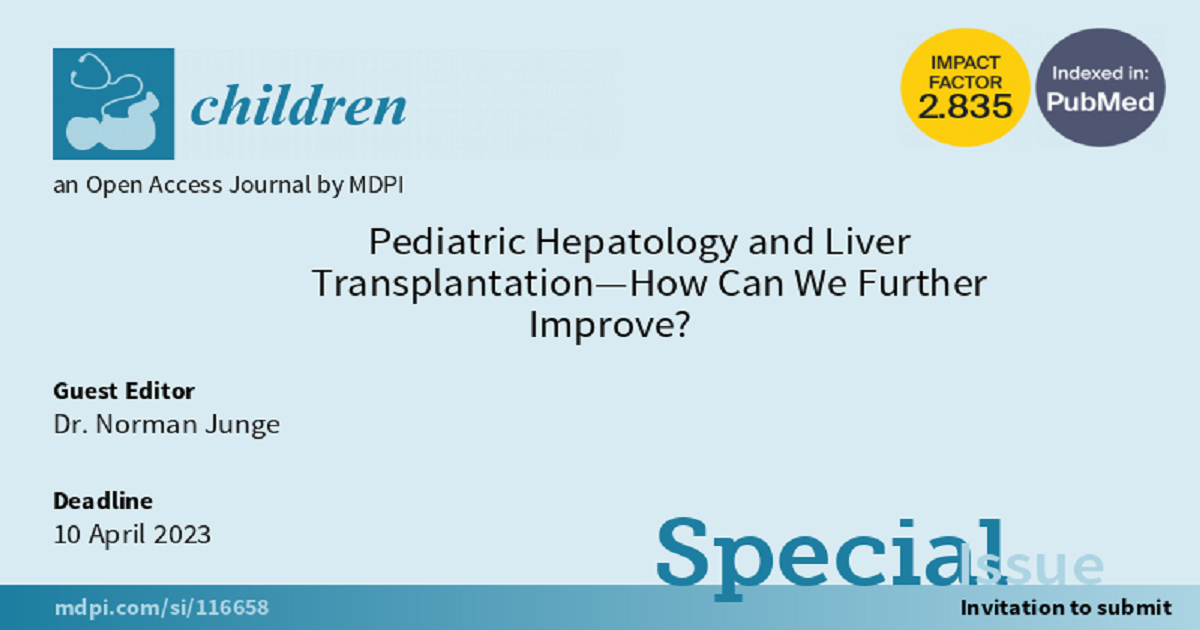Pediatric Hepatology and Liver Transplantation—How Can We Further Improve?
A special issue of Children (ISSN 2227-9067). This special issue belongs to the section "Pediatric Surgery".
Deadline for manuscript submissions: closed (10 April 2023) | Viewed by 16001

Special Issue Editor
Special Issue Information
Dear Colleagues,
Pediatric hepatology usually deals with rare diseases, but is also involved in many multi-systemic diseases. The liver is a unique organ in many aspects, making medical care for liver diseases challenging and multidisciplinary. End-stage liver disease has a substantial effect on many other organs, and liver non-function cannot be replaced by a machine. The liver is center of most metabolic pathways, and is therefore an important target for gene therapy, which has the potential to replace liver transplantation for some diseases in future. Additionally, recent improvements to genetic diagnostic tools have increased the number of known inherited liver diseases. Altogether, this background illustrates what a dynamic and important field pediatric hepatology and liver transplantation is. For “typical” pediatric liver disease, but also for liver diseases which can manifest at any age, it is shown that the disease course differs depending on the age of manifestation. However, studies in the pediatric field are often hampered by small numbers of patients and ethical issues. We want to encourage our colleagues to submit their important research with a specific focus on pediatric hepatology to this Special Issue.
Dr. Norman Junge
Guest Editor
Manuscript Submission Information
Manuscripts should be submitted online at www.mdpi.com by registering and logging in to this website. Once you are registered, click here to go to the submission form. Manuscripts can be submitted until the deadline. All submissions that pass pre-check are peer-reviewed. Accepted papers will be published continuously in the journal (as soon as accepted) and will be listed together on the special issue website. Research articles, review articles as well as short communications are invited. For planned papers, a title and short abstract (about 100 words) can be sent to the Editorial Office for announcement on this website.
Submitted manuscripts should not have been published previously, nor be under consideration for publication elsewhere (except conference proceedings papers). All manuscripts are thoroughly refereed through a single-blind peer-review process. A guide for authors and other relevant information for submission of manuscripts is available on the Instructions for Authors page. Children is an international peer-reviewed open access monthly journal published by MDPI.
Please visit the Instructions for Authors page before submitting a manuscript. The Article Processing Charge (APC) for publication in this open access journal is 2400 CHF (Swiss Francs). Submitted papers should be well formatted and use good English. Authors may use MDPI's English editing service prior to publication or during author revisions.
Keywords
- pediatric liver disease
- pediatric liver transplantation
- pediatric autoimmune liver disease
- liver-based metabolic diseases
- gene therapy
- congenital cholestatic liver disease
- management of liver cirrhosis
- extrahepatic manifestations of liver cirrhosis
- transition






